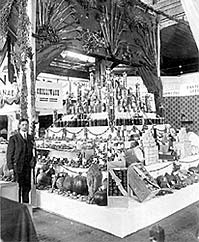
Isaac Kipp (1839 - 1921) pre-empted part of this prairie land lots 29 and 30, around 1862. Part of Lot 29 eventually became the Fairgrounds. By 1866, along with partners Jonathan Reece and Henry Kipp, they had cultivated 350 acres, fenced with 40,000 rails, built sheds and barns, cut 165 tons of hay, pastured 340 head of cattle and 20 horses, manufactured 1,500 pounds of cheese and cultivated corn, potatoes, turnips and other garden vegetables (Orchard, p. 15). In a few short years, the land was transformed, an incredible feat performed with crude technologies. This work, on the land that is the Fairground site, represents the beginning of Chilliwack's long association with agricultural pursuits.
The history of Chilliwack Fairs, and the Agricultural Society are linked to the Kipp pre-emptions. The Chilliwack Agricultural Society was formed in 1873 and fairs soon followed. Early fairs were held on the farms of members, Jonathan Reece and Henry Kipp, Isaac's brother. Purchases of land from Isaac Kipp in 1884 and 1887 established the first Fairgrounds - the block bounded by Wellington, Mary, Princess and Edward Streets (Chilliwack Fair History, Down Country Roads, Chilliwack Museum and Historical Society, nd, p.9).
The Agricultural Society and the City purchased land from Williams Hodgins for the Fair at its next site in 1909. The following year the Chilliwack Progress, September 28, 1910, reported that "the three day exhibition will go on record as the most successful display of the products of the rich Chilliwack valley, one of the richest section of the Fraser River Valley."
The success was attributed to the drawing power of the "speeding" or horse racing events. These events took place on the newly completed "splendid half-mile" racetrack.
The 1910 Fair had other attractions as well. The Chilliwack team who beat Rosedale 5 to 1 won the Parsons and Reynolds baseball trophy. Soccer and football matches were also featured. In field sports, an assortment of running races were held while G.W. Bowden won the men's pillow fighting contest and H. Nelems won the boys, under 15, contest.
The Agricultural Society, however, noted that the primary objects of the exhibition were educational. "The agricultural society, they said, is an educational institution organized for the purpose of promoting and encouraging the breeding of live stock and the exhibition of grain, fruit, etc." (Chilliwack Progress, July 27, 1910). Great emphasis was therefore placed on this aspect of the Fair. "In no one district in Canada of a like size could better stock be found," reported the Chilliwack Progress, September, 28, 1910.
The site expanded in 1935 when the City sold a group of lots on Corbould Street to the Agricultural Society.
The last fair at this site is scheduled to take place in 2000. The fair is once again on the move, this time to make way for new public and private developments.


Aerial view of the Chilliwack Exhibition grounds as they appeared between 1958 and 1971. Norm Williams photograph.
Prominent Chilliwack citizens having a watermelon eating contest at the Chilliwack fair. P.Coll 71, file 3.
